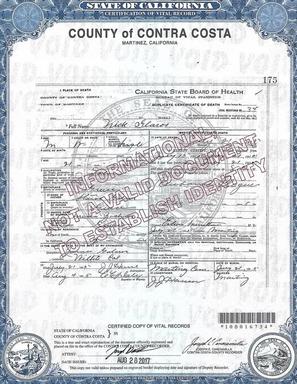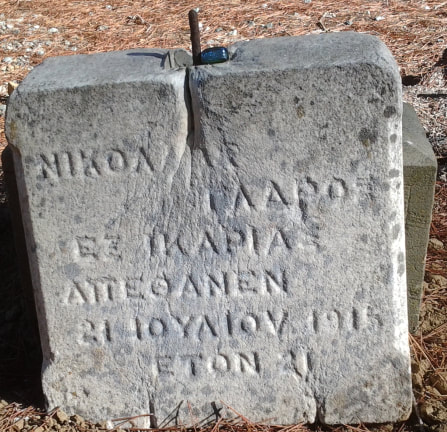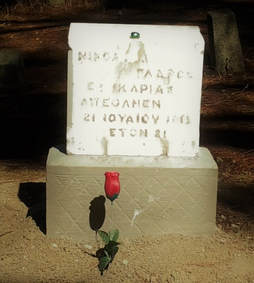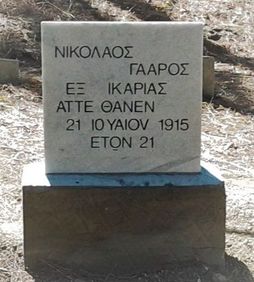Headstone
Headstone Inscription: (Translated from Ancient Greek)
Nikolao Glaros from Ikaria Ascended 21 July 1915 Year 21
Nikolao Glaros from Ikaria Ascended 21 July 1915 Year 21
Biography

Nikolao Glaros came from Icaria, Greece and was born in May of 1894. We found Passenger Lists, 1820-1957 that possiblynshows Nick arriving at the New York Harbor on September 28, 1906. According to the Passenger list, Nick was 11 years and 11 months when he arrived.
Icarians began to settle in America in the 1890's. In the Western States, they labored on railroad construction and in mines. As early as 1907, it was estimated by the New York Greek Consul General that there were between 30,000 and 40,000 Greek laborers in the American West. Greek railroad laborers were especially concentrated in California, where in 1910, there were more Greeks proportionate to the total state population than anywhere else in the U.S.
Many of the Icarian immigrants expected to work and return to their homeland after earning capital and dowries for their families. Perhaps that was Nick's plan.
According to his death certificate, he was born in Ikaria, Greece, to Staros Glaros and Maria Zachros. He lived in California for nine years and possibly spent time in Willits, CA with his brother, James Glaros (informant on death certificate). He was 21 years old at the time of his death.
According to newspaper articles in the 1915 Martinez Gazette and Martinez Daily Standard, we know that Nick was on the section gang for the Oakland, Antioch and Eastern Railroad. His job was to make sure the rail lines were inspected, repaired and maintained. It was a physically demanding job that took Nick wherever the railway took him. For whatever reason, Nick slept on straw near the Moraga railway station on the night of July 9, 1915. He began to show symptoms of illness on July 13th and saw a doctor Concord, who called a Federal health officer and took him to the County Hospital in Martinez, California for examination. He was immediately isolated from all other patients. A bubo was found on his right femoral region and was examined by placing some of the fluid into two guinea pigs. The guinea pigs died in five days. Upon post-mortem examination of the pigs, it was confirmed that Nick had been bitten by an infected squirrel and died from Bubonic Plague. Nick's brother, James, attempted to see him but was not allowed by Dr. Edwin Meritthew, Nick's doctor. Nick died on July 21, 1915 at 8PM, in the Martinez County Hospital. He was immediately buried. According to the Martinez Daily Standard, "His body was placed in a steel sepulchre and quick lime was poured over it. Then the entire casket was soldered and made air tight." Nick was buried on the same day by Deputy Coroner, J. J. Hauser. He was assisted by Bert Heath, the local plumber, who sealed up the crevices. As soon as Nick was laid in Alhambra Cemetery's Potter's Field, both Hauser and Heath took off their clothes and burned them as well as washing their hands with strong disinfectant.
His case was the only one in the state since October of 1913 when another case appeared in the same county at Walnut Creek. Nikolao's case was investigated in the field and in the laboratory by the United States Public Health Service. An investigation was also conducted with his culture by the State Hygienic Laboratory.
Nick's death created an extended campaign against the plague which was conducted in Contra Costa County by the State and County Boards of Health. His case reached many medical research reports, bulletins and records in the United States, including Texas Medicine. He was also in the Tulsa Daily World newspaper on Friday, August 12, 1915.
Nick's headstone was repaired and reinstalled on Monday, September 18, 2017 by the Napa Monument Co. and funded by Dorothy Glaros and the Pan Ikarian Brotherhood Association. The rusty nail was removed and cracks were repaired, along with a well deserved cleaning. The opposite side is new stone with the original Greek lettering newly etched into the stone. The headstone has been secured into the base with new stainless steel rods.
This post was updated on April 26, 2023.
Icarians began to settle in America in the 1890's. In the Western States, they labored on railroad construction and in mines. As early as 1907, it was estimated by the New York Greek Consul General that there were between 30,000 and 40,000 Greek laborers in the American West. Greek railroad laborers were especially concentrated in California, where in 1910, there were more Greeks proportionate to the total state population than anywhere else in the U.S.
Many of the Icarian immigrants expected to work and return to their homeland after earning capital and dowries for their families. Perhaps that was Nick's plan.
According to his death certificate, he was born in Ikaria, Greece, to Staros Glaros and Maria Zachros. He lived in California for nine years and possibly spent time in Willits, CA with his brother, James Glaros (informant on death certificate). He was 21 years old at the time of his death.
According to newspaper articles in the 1915 Martinez Gazette and Martinez Daily Standard, we know that Nick was on the section gang for the Oakland, Antioch and Eastern Railroad. His job was to make sure the rail lines were inspected, repaired and maintained. It was a physically demanding job that took Nick wherever the railway took him. For whatever reason, Nick slept on straw near the Moraga railway station on the night of July 9, 1915. He began to show symptoms of illness on July 13th and saw a doctor Concord, who called a Federal health officer and took him to the County Hospital in Martinez, California for examination. He was immediately isolated from all other patients. A bubo was found on his right femoral region and was examined by placing some of the fluid into two guinea pigs. The guinea pigs died in five days. Upon post-mortem examination of the pigs, it was confirmed that Nick had been bitten by an infected squirrel and died from Bubonic Plague. Nick's brother, James, attempted to see him but was not allowed by Dr. Edwin Meritthew, Nick's doctor. Nick died on July 21, 1915 at 8PM, in the Martinez County Hospital. He was immediately buried. According to the Martinez Daily Standard, "His body was placed in a steel sepulchre and quick lime was poured over it. Then the entire casket was soldered and made air tight." Nick was buried on the same day by Deputy Coroner, J. J. Hauser. He was assisted by Bert Heath, the local plumber, who sealed up the crevices. As soon as Nick was laid in Alhambra Cemetery's Potter's Field, both Hauser and Heath took off their clothes and burned them as well as washing their hands with strong disinfectant.
His case was the only one in the state since October of 1913 when another case appeared in the same county at Walnut Creek. Nikolao's case was investigated in the field and in the laboratory by the United States Public Health Service. An investigation was also conducted with his culture by the State Hygienic Laboratory.
Nick's death created an extended campaign against the plague which was conducted in Contra Costa County by the State and County Boards of Health. His case reached many medical research reports, bulletins and records in the United States, including Texas Medicine. He was also in the Tulsa Daily World newspaper on Friday, August 12, 1915.
Nick's headstone was repaired and reinstalled on Monday, September 18, 2017 by the Napa Monument Co. and funded by Dorothy Glaros and the Pan Ikarian Brotherhood Association. The rusty nail was removed and cracks were repaired, along with a well deserved cleaning. The opposite side is new stone with the original Greek lettering newly etched into the stone. The headstone has been secured into the base with new stainless steel rods.
This post was updated on April 26, 2023.



